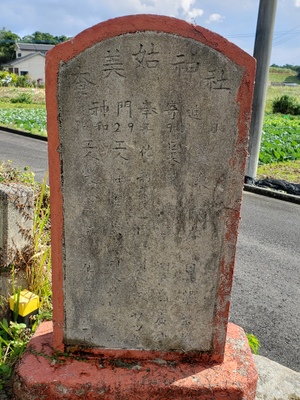Amamikyo

- Japanese: 奄美姑・阿麻弥姑 (Amamiko, Amamikyo; Amami language: Amamiku, Amamikyu; Okinawan language: Amanchu, Amamichu)
Amamikyo is the primary primordial creation goddess in Ryukyuan origin myths. Along with her male counterpart Shinerikyo, Amamikyo is credited with creating the Ryukyu Islands themselves, as well as numerous gusuku and utaki (sacred sites),[1] and with introducing rice cultivation and other technologies.
According to the Chûzan seikan written by Haneji Chôshû in 1650, Amamikyo and Shinerikyo created, or begat, a further three male deities and two female deities. The eldest of the male deities was known as Kuninushi (lit. "master of the land") or Tensonshi (lit. "descended from heaven"), the second was said to be the progenitor of the anji nobility, and the third the progenitor of the common people. The elder of the two female deities was said to be the progenitor of the line of kimigimi priestesses, including the line of Kikoe-ôgimi, chief priestesses of the kingdom. The younger of the two female deities was said to be the progenitor of the regional noro priestesses.[2]
Locations
While some myths assert that she first came down to earth at Kudaka Island and then crossed over to Okinawa Island at Sefa utaki - hence these two sites being the most sacred sites on/near Okinawa - others relate the story of the creation of the world, then the islands, then the utaki and gusuku, in a narrative progression moving from north to south. Some suggest that Amamikyo started in Amami and then moved south to Okinawa island group, coming ashore first at Iheya Island.[2] Legends in northern Okinawa assert that Asumui utaki, a sacred grove at the northern tip of Okinawa, Hedo no misaki, was the first such sacred grove she created.[3] Scholars such as Gregory Smits have tied this legendary southward progression to actual historical migration of peoples southward from the more northerly islands into Okinawa, bringing with them cultural customs as well as technologies such as iron working and rice agriculture.[4] Some have further suggested that the name of the deity itself may derive from, or literally mean, "a person" or "people" from "Amami,"[5] or more simply, "sea people," i.e. "mariners."[2]
A site on Hamahiga Island (a tiny island just off the coast of the Katsuren peninsula of the Okinawa Island "mainland") is traditionally identified as the grave of Amamikyo.[6]
References
- Gregory Smits, Maritime Ryukyu, University of Hawaii Press (2019), 125.
- ↑ Sites which Amamikyo is credited with creating include Tamagusuku gusuku, Goeku gusuku, and Iso gusuku, among many others. Only four gusuku are explicitly associated with Amamikyo in the Omoro sôshi, however. Kitahara Shûichi. A Journey to the Ryukyu Gusuku 琉球城紀行。 Naha: Miura Creative, 2003. pp66-67, 89.; Smits, Maritime Ryukyu, 125-126.
- ↑ 2.0 2.1 2.2 Yamazato Eikichi, "Shinwa to densetsu ni miru Okinawa no rekishi," Tabi 旅 46 (1972/6), 108.
- ↑ Smits, Maritime Ryukyu, 152.
- ↑ Smits, Maritime Ryukyu, 125.
- ↑ The goddess is often called Amamichu in the Okinawan language; in that same language, a person from Amami would be called Amaminchu. "Amamikyo," Okinawa Compact Encyclopedia, Ryukyu Shimpo, 2003.
- ↑ Plaques on-site.; Aike Rots, "Strangers in the Sacred Grove: The Changing Meanings of Okinawan Utaki," Religions 10:298 (2019), 10.